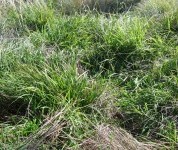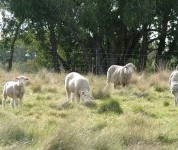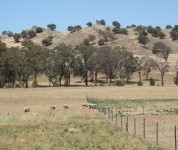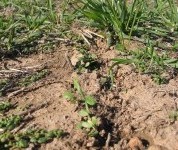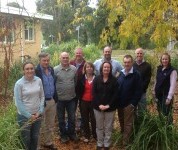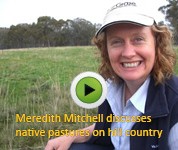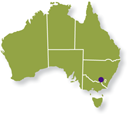Key Results
Click on the key result heading to see full information.
Grazing system, fertiliser and seasonal influences on pasture composition
Pasture production higher with increased soil fertility
- At Chitern, there was no difference in herbage mass between high fertiliser input (21 kg P/ha every year) and low fertiliser input (11 kg P/ha every second year) treatments throughout the experiment. This indicates that the pasture production response to the higher fertiliser rates was equivalent to the consumption of the additional ewes carried on the high fertiliser treatment (5 ewes/ha compared to 3 ewes/ha).
Grazing system, fertiliser and stocking rate didn’t influence composition
- During the short period of the experiment, and while thresholds for destocking based on ground cover (70%) and feed on offer (800 kg/ha) were in place, there were no pasture composition differences between grazing systems (simple 4-paddock versus set stocking) or stocking rate (low and high).
- In contrast to expectations, there was no increase in the annual grass or clover composition or decrease in native grass composition in response to phosphorus fertiliser inputs at Chiltern. This was most likely a result of the initial composition – high native grass (>60%), low clover (<3%) and lack of fertiliser-responsive annual species.
- Early data analysis for a second site at Holbrook also indicated that there were no differences in pasture composition between native pastures which were set stocked compared to those that were strategically grazed in combination with phalaris pastures. This was also consistent with findings from the Orange Proof Site which showed no difference in pasture composition between 1-Paddock, 4-Paddock and 20-Paddock systems.
- Composition results at Tallangatta Valley, Murmungee and Warrak Supporting Sites were, for the most part, very consistent with findings at the Proof Sites.
- At all sites, pasture composition and production may have changed under the different management regimes if the experiments were run for longer and through a greater range of seasonal conditions.
Microlaena and wallaby grass cover increased with summer rainfall and managing to pasture benchmarks
- At Chiltern, average Microlaena basal cover (over all treatments) increased steadily from 7% (2008) to 28% (2011). This was most likely due to spread of existing plants in response to managing to herbage mass and ground cover benchmarks, and high summer rainfall in 2010. This finding was also consistent with the Orange Proof Site.
- Wallaby grass basal cover dramatically increased (from around 2% to 14%) in the fourth year, most likely due to recruitment of new plants in response to summer rainfall events in 2010 and 2011 and a reduced 2011-12 summer stocking rate.
Broadcasting sub clover was unsuccessful at Chiltern
- Broadcasting sub clover with superphosphate fertiliser did not result in any increase in clover percentage.
- This was consistent with results at Holbrook which showed that direct drilling clover was successful but broadcasting was not.
Lamb production and economics on native pastures at Chiltern
High weaning percentages on native pastures when ewes were managed to Lifetimewool condition scores
- When managed to Lifetimewool condition score recommendations (average 2.7 at lambing and with a 0.5 condition score loss post lambing), weaning percentages of dual purpose Merino (CentrePlus) ewes joined to terminal (Dorset) sires grazing native pastures were acceptable (117%-126%) for a profitable lamb production system.
Native pastures suited store lamb production
- At Chiltern EverGraze Proof Site, on native pastures comprising Microlaena stipoides, low quality annual grasses and very low clover, average lamb growth rates to weaning (November) ranged from 206 g/hd/day – 320 g/hd/day (depending on season), equating to average weaning weights of 29-32 kg respectively.
- In one good year when lambs were taken beyond weaning, post weaning growth rates declined to a point where productivity was compromised – the first sale group averaged only 96 g/hd/day from weaning through to sale (start of February), while the group that was retained longer (mid-March) only averaged 67 g/hd/day.
Response to capital fertiliser rates insufficient to justify the cost until dropped to maintenance levels
- The higher stocking rate high fertiliser input system had greater per hectare lamb production (78 kg/ha – 165 kg/ha) than lower stocked low fertiliser input system (49 kg/ha -101 kg/ha) despite the fact that per head production at higher stocking rates tended towards lower weaning weights (average 32 kg vs 36kg).
- Whilst it might be expected that there would be a difference in ewe condition score and liveweight between stocking rate and rotational grazing treatments, this was not the case indicating that even at the high stocking rate, pasture availability was not limiting performance.
- The higher stocking rate (5 ewes/ha vs 3 ewes/ha) in the high fertiliser treatment resulted in an increase in per hectare lamb production (average 39 kg/ha equating to $96/ha additional income) and wool income ($52/ha). However this was insufficient to offset the additional fertiliser, feeding and other additional operating expenses during the experiment.
- In a modelled scenario, when the high fertiliser rate was dropped back to maintenance and high stocking rates were still maintained, the gross margin of the high stocking scenario was $98/ha compared to $86/ha for the low input set stocked system.
Lower per head production from rotational grazing
- At the higher stocked rates, the set stocked treatment had 13.2-31.1kg/ha greater lamb production at weaning than the rotationally grazed treatment. This is in line with the trend towards greater per head performance that was observed in the set stocked treatments, and has also been observed in other experiments (eg. Orange Proof Site). To capitalise on implementation of rotational grazing, higher stocking rates to achieve greater utilisation would be required (see Broadford Grazing Experiment and Orange Proof Site).
Economic analysis of integrated versus separate grazing systems at Holbrook
- An analysis of historical (1991-2011) lamb and wool prices was combined with Holbrook Proof Site production data (2008-2010). For five of the six price scenarios, an integrated system where dual purpose Merino ewes were rotated between native and improved pastures, was significantly more profitable than a separate system where ewes grazed improved pastures and wethers were set stocked on native pastures.
Publications
Report
EverGraze Impact Report – June 2011 to June 2012
The purpose of this report is to summarise the Impact of the EverGraze project based on evaluation data collected from activities between July 2011 an…
Read MoreEverGraze; 2012; EverGraze
Webpage
Microlaena Ecology Study
Microlaena stipoides (weeping grass or Microlaena) is found throughout the high rainfall zones from mountains of Cape York Peninsula through New South…
Read MoreMeredith Mitchell, Kate Sargeant; 2013; EverGraze website, Future Farm Industries CRC
Select
Holbrook Caring For Our Country EverGraze Supporting Site (John and Anne Keogh)
Implementing whole farm grazing strategies in southern NSW Also see Implementing whole farm grazing strategies at Holbrook case study and the final re…
Read MoreHirth J, Sargeant K, Ekberg T, Hunter B; 2013; EverGraze, Future Farm Industries CRC
Select
Native pastures Directions Paper
Following a brief historical overview of the development of native pastures, a description of their current state is presented. This will, by necessit…
Read MoreJim Virgona; 2006; EverGraze, Future Farm Industries CRC
Webpage
Microlaena ecology and management
Microlaena can spread by stolons, rhizomes and tillers arising from corms beneath the surface. The rhizomes and corms protect the plant from heavy gra…
Read MoreMitchell, M; 2013; EverGraze, Future Farm Industries CRC
Video or Audio
Improving native grasses on hill country
This video is a short interview with Meredith Mitchell who talks about the importance of improving native pastures on hill country and how to graze na…
Read MoreMitchell M; 2008;
Journal article
Evaluating seasonal risk and the potential for windspeed reductions to reduce chill index at six locations using GrassGro
The death of newborn lambs is a major factor influencing the reproductive efficiency of sheep enterprises. Adverse weather conditions (wind, precipita…
Read MoreBroster JC, Robertson SM, RL Dehaan, BJ King, Friend MA; 2012; Animal Production Science 52, 921-928
Conference paper
Grazing management principles – how to get the most out of your pastures through grazing management
Getting the most of out of pastures with grazing management involves decisions which influence the effective utilisation of the available feed within…
Read MoreSargeant K; 2012; Grassland Society of Southern Australia 2012 pp. 11
Conference paper
EverGraze – developing sustainable livestock production systems
To access this resource you will need to be a member of the website on which this resource is held
Read MoreAvery A, Saul G, Young J, Sanford P, Friend M, Masters D; 2006; International Landcare Conference, Melbourne, Victoria
Conference paper
Native grasses – how they stack up
Native grass is a general term for the 1300 or so grasses that occurred naturally in Australia before European settlement. Whether it is a native or i…
Read MoreMitchell M; 2008; Proceedings of the 49th Annual Conference of the Grassland Society of Southern Australia. Bairnsdale pp 11-17

